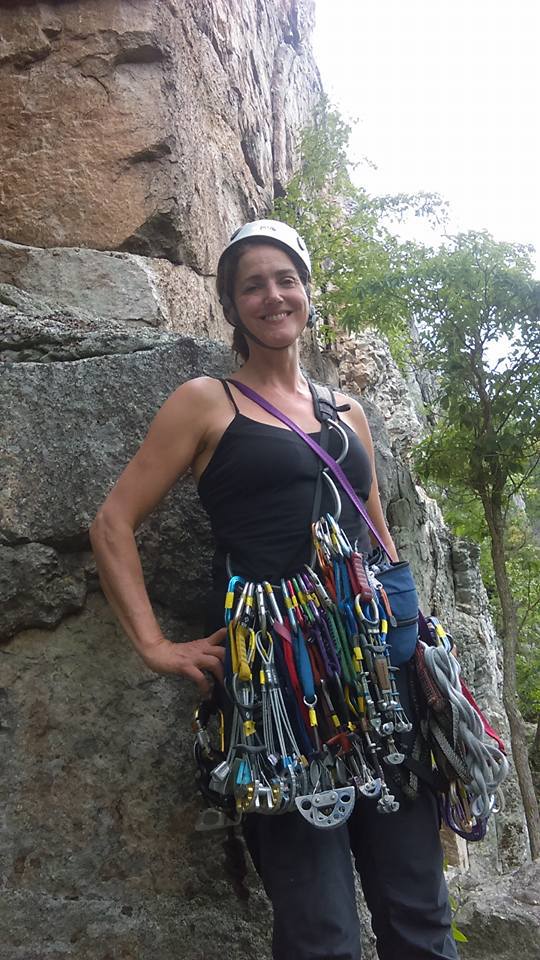The fear of falling is common — but you can get past it with the right mental training tools and support from your climbing community. If you struggle with the fear of falling while lead climbing, join Sandy Morris for the Zen Of Falling Workshop on Wednesday January 10th at 7:00 pm at FA Avondale!
For most climbers, there is no greater feeling than attempting a new route, journeying into the unknown and proving to yourself that you have what it takes to overcome the route’s physical and mental challenges. And most of the time, we do just that. But for many climbers, the fear of falling, particularly the fear of “taking a whip” while lead climbing, is very real and extremely debilitating – sometimes holding them back from finishing a route they are physically and mentally capable of completing. The good news is, getting past this fear is absolutely achievable with a combination of strength training, mental focus, and a little help from your friends.
A recent conversation with Sandy Morris, a First Ascent Learning to Lead and Gym to Crag instructor and 18-year climbing veteran , reminded us that it is important to distinguish the fear of falling, or basophobia, from the fear of heights. The two aren’t the same, and for most climbers, acknowledging the difference is the first step to getting back on the wall after a fall or an injury.
, reminded us that it is important to distinguish the fear of falling, or basophobia, from the fear of heights. The two aren’t the same, and for most climbers, acknowledging the difference is the first step to getting back on the wall after a fall or an injury.
When Sandy started climbing, she loved climbs with ample exposure. The feeling of air all around her made climbing exciting and fun. After a couple of injuries, however, Sandy had to work through her own fear of falling and make her way back to climbing through rigorous mental re-training and physical strength training. Sandy developed a thoughtful approach to overcoming her basophobia by acknowledging that the stronger she felt physically, the easier climbing became. She also recognized that basophobia was largely a ‘head game,’ one that should could control with the right mental tools. In her new workshop, The Zen of Falling, Sandy will help those with basophobia to reclaim their power on the wall.

Here is a list of things Sandy suggests for moving past the fear of falling:
- Head to the gym! Getting back on the wall is the first step in conquering your fear. You cannot really address your fear of falling until you start to climb regularly.
- Understand what you’re afraid of is falling, not heights. The part of your brain saying, “Dude, you shouldn’t be doing this,” is holding on to the feeling of past injury or the fear of the unknown. Getting up on the wall will remind you that height is not the problem.
- Understand that the fear of falling isn’t such a bad thing. Fear is what prevents us from taking unsafe risks. Assessing risk and making good choices is what keeps you safe, and confidence in your ability to climb without getting seriously injured allows you to keep on climbing. The key is to understand where that fear originates and not allow it undue control over your thinking once you’ve assessed risk and chosen to move forward with a climb.
- Start climbing in a corner. Exposure adds to the rush during a climb – and the fear factor. The more exposed you are to open air, the more intense your fear will feel. Dihedral climbs (where you’re climbing in an inside corner) will make you feel protected and confident. Once you gain confidence on dihedral climbs, you can start to try vertical face climbing, then move to overhangs and arêtes (or outside corners) – the most exposed climbing terrain.
- Take practice falls. The only way to build trust that your equipment and belayer are trustworthy is to trust them and take a fall. The hardest part is letting go. Once you’re sitting safely in your harness, you realize that your belayer’s got you.
- Lean on your climbing community! Knowing you have a group of friends that share, or at least sympathize with, your fear of falling will help you conquer your fear. Talk about your fear with your friends before a climb and ask for their encouragement, then let them cheer you on as you get moving.
- Build strength. A combination of cardio and light weight lifting will help you get into top climbing shape. The stronger you feel, the more confident you’ll feel on the wall. Combine your strength training with intense stretching through yoga or a similar activity. Getting strong, flexible, and agile will give you an edge during a climb.
- Reprogram your brain. This is much easier said than done, but mental training is just as important as physical training when you are working to overcome basophobia. In The Rock Warrior’s Way, author and climber Arno Ilgner discusses unjustified fears in climbing and provides step-by-step guidance on how to assess risk, improve mental focus, and put fear in its place.
Through The Zen of Falling, Sandy will help students get comfortable talking about their fear of falling with other climbers so they are encouraged to get past it. “In my head, I just have to have a little talk with my brain constantly, reminding myself that my equipment is in good working order and my belayer is trustworthy,” says Sandy. Under Sandy’s tutelage, students will climb an overhanging route and practice “clean” falls. The more students fall with the right protection in place, the more they have confidence to climb at their true ability level.
